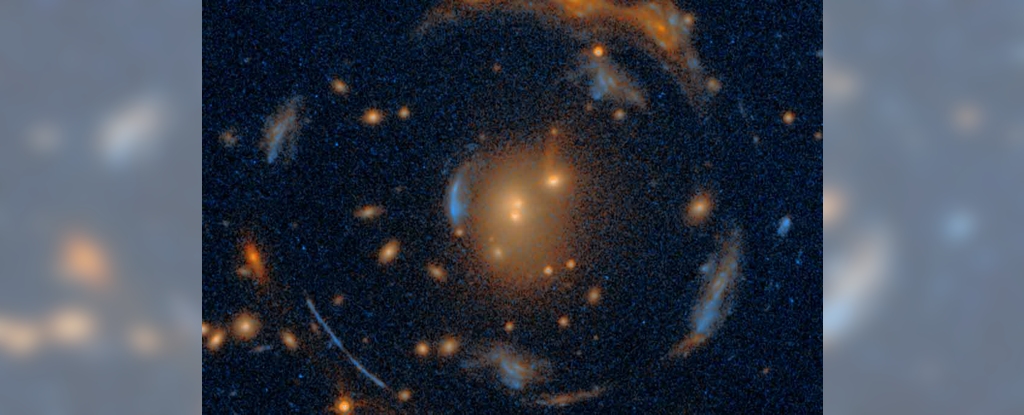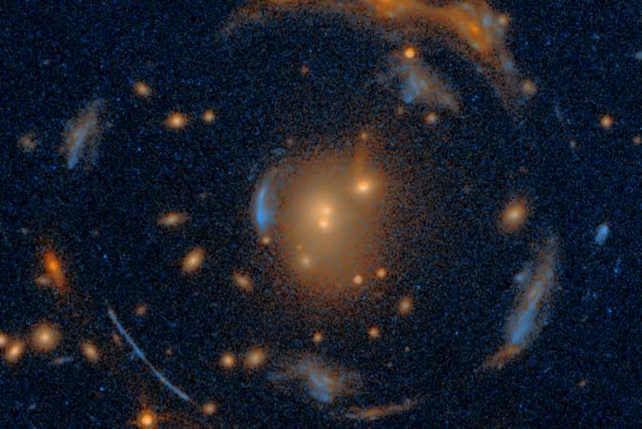
A gravitational lens is the ultimate funhouse mirror of the Universe. It distorts the view of objects behind them but also supplies amazing information about distant galaxies and quasars.
Astronomers using Hubble Space Telescope (HST) recently released a new image of one of these weird apparitions called “The Carousel Lens”. It’s a rare alignment of seven background galaxies that all appear distorted by an intervening galaxy cluster.
According to Berkeley Lab senior scientist David Schlegel, this gravitational lens is a great find for astronomers.

“This is an amazingly lucky ‘galactic line-up’—a chance alignment of multiple galaxies across a line-of-sight spanning most of the observable Universe,” he said. “Finding one such alignment is a needle in the haystack. Finding all of these is like eight needles precisely lined up inside that haystack.”
The Carousel Lens was uncovered in Dark Energy Survey data a few years ago. Now astronomers are zeroing in on it to measure its mass and the effects on the images of more distant galaxies.
This gravitational lens alignment of seven galaxies and a foreground galaxy cluster could well provide new insights into the early Universe via the high- redshift galaxy sources, the properties of the lensing cluster, and unanswered questions in cosmology.
Deconstructing the Carousel Gravitational Lens
Typical large-scale gravitational lenses in the Universe consist of a “lensing object” and more distant objects behind it. Generally, those distant objects are galaxies and quasars. (Small-scale gravitational lenses occur when a planet passes in front of its star, for example.)
However, the Carousel Lens is more “cosmic” in nature, covering objects millions of light-years apart. In particular, the cluster doing the lensing is about 5 billion light-years from Earth. It’s also designated as DESI-090.9854-35.9683 and has at least four large galaxy members as well as several other possible cluster members.
The Carousel lenses at least seven distant galaxies. They lie anywhere from 7.62 to 12 billion light-years away from Earth. Their alignment with the lensing cluster resulted in multiple images of each of the more distant galaxies.
Their shapes are the result of the “funhouse mirror” effect that stretches their apparitions. The galaxy labeled “4a, 4b, 4c, 4d” actually forms a nearly perfect “Einstein Cross”, which shows the symmetrical distribution of mass in the lens.
The Carousel is a great example of a “strong lens” in the Universe, according to Xiaoshang Huang, who is part of the team at Berkeley studying it.
“Our team has been searching for strong lenses and modeling the most valuable systems,” said Huang.
“The Carousel Lens is an incredible alignment of seven galaxies in five groupings that line up nearly perfectly behind the foreground cluster lens. As they appear through the lens, the multiple images of each of the background galaxies form approximately concentric circular patterns around the foreground lens, as in a carousel.
“It’s an unprecedented discovery, and the computational model generated shows a highly promising prospect for measuring the properties of the cosmos, including those of dark matter and dark energy.”
What Makes this Lens So Special?
In their recently released paper, Schlegel, Huang, and others described modeling the Carousel Lens to understand its structure. They point out that it shows nearly every lensing configuration that astronomers see in such apparitions. There are various arcs, diamond shapes, the Einstein Ring, and double lensing.
The big spread of distances between the lens itself and the galaxies it’s distorting also presents some interesting cosmological areas of study. In particular, the science team hopes to do more spectral studies to understand the lensing cluster’s matter distribution.
At least seven lensed sources will help constrain the amount of matter in the cluster and aid in understanding the amounts of dark and baryonic matter in such systems.
In addition to matter distribution, the team can also use this lensing system as a way to understand the characteristics of the distant lensed sources. This is important because the most distant ones give insight into conditions in their various epochs of cosmic history.
For example, source 7 is an interesting “nearby” source that could be a very high-redshift “quiescent” galaxy. It appears to be very “red” in infrared measures and others of this sort have been observed by HST. Source 7 could be an efficient example of what’s called “early galaxy quenching”.
That occurs when star formation shuts down and the galaxy becomes quiescent. There are several ways that could happen, but the most common is some kind of feedback loop between the central supermassive black hole and outlying regions. This could occur as a result of galaxy mergers, for example, which were very common in the early Universe.
The Carousel Lens (and others of its type) provides a special way to study that epoch of cosmic history and the events that shaped the galaxies we see today.










